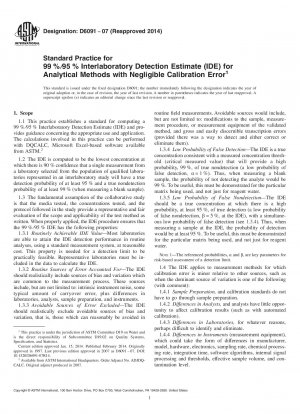ASTM D6091-07(2014)
Standard Practice for 99?%/95?% Interlaboratory Detection Estimate 40;IDE41; for Analytical Methods with Negligible Calibration Error
- Standard No.
- ASTM D6091-07(2014)
- Release Date
- 2007
- Published By
- American Society for Testing and Materials (ASTM)
- Latest
- ASTM D6091-07(2014)
- Scope
5.1 Appropriate application of this practice should result in an IDE achievable by most laboratories properly using the test method studied. This IDE provides the basis for any prospective use of the test method by qualified laboratories for reliable detection of low-level concentrations of the same analyte as the one studied in this practice and same media (matrix).
5.2 The IDE values may be used to compare the detection power of different methods for analysis of the same analyte in the same matrix.
5.3 The IDE provides high probability (approximately 958201;%) that result values of the method studied which exceed the IDE represent presence of analyte in the sample and high probability (approximately 998201;%) that blank samples will not result in a detection.
5.4 The IDE procedure should be used to establish the interlaboratory detection capability for any application of a method where interlaboratory detection is important to data use. The intent of IDE is not to set reporting limits.
1.1 This practice establishes a standard for computing a 998201;%/958201;% Interlaboratory Detection Estimate (IDE) and provides guidance concerning the appropriate use and application. The calculations involved in this practice can be performed with DQCALC, Microsoft Excel-based software available from ASTM.2
1.2 The IDE is computed to be the lowest concentration at which there is 908201;% confidence that a single measurement from a laboratory selected from the population of qualified laboratories represented in an interlaboratory study will have a true detection probability of at least 958201;% and a true nondetection probability of at least 998201;% (when measuring a blank sample).
1.3 The fundamental assumption of the collaborative study is that the media tested, the concentrations tested, and the protocol followed in the study provide a representative and fair evaluation of the scope and applicability of the test method as written. When properly applied, the IDE procedure ensures that the 998201;%/958201;% IDE has the following properties:
1.3.1 Routinely Achievable IDE Value—Most laboratories are able to attain the IDE detection performance in routine analyses, using a standard measurement system, at reasonable cost. This property is needed for a detection limit to be practically feasible. Representative laboratories must be included in the data to calculate the IDE.
1.3.2 Routine Sources of Error Accounted For—The IDE should realistically include sources of bias and variation which are common to the measurement process. These sources include, but are not limited to: intrinsic instrument noise, some typical amount of carryover error, plus differences in laboratories, analysts, sample preparation, and instruments.
1.3.3 Avoidable Sources of Error Excluded—The IDE should realistically exclude avoidable sources of bias and variation, that is, those which can reasonably be avoided in routine field measurements. Avoidable sources would include, but are not limited to: modifications to the sample, measurement procedure, or measurement equipment of the validated method, and gross and easily discernible transcription errors (provided there was a way to detect and either correct or eliminate them).
ASTM D6091-07(2014) Referenced Document
- ASTM D2777 Standard Practice for Determination of Precision and Bias of Applicable Methods of Committee D-19 on Water
ASTM D6091-07(2014) history
- 2007 ASTM D6091-07(2014) Standard Practice for 99?%/95?% Interlaboratory Detection Estimate 40;IDE41; for Analytical Methods with Negligible Calibration Error
- 2007 ASTM D6091-07 Standard Practice for 99 %/95 % Interlaboratory Detection Estimate (IDE) for Analytical Methods with Negligible Calibration Error
- 2003 ASTM D6091-03 Standard Practice for 99 %/95 % Interlaboratory Detection Estimate (IDE) for Analytical Methods with Negligible Calibration Error
- 1997 ASTM D6091-97 Standard Practice for 99 %/95 % Interlaboratory Detection Estimate (IDE) for Analytical Methods with Negligible Calibration Error

Copyright ©2024 All Rights Reserved